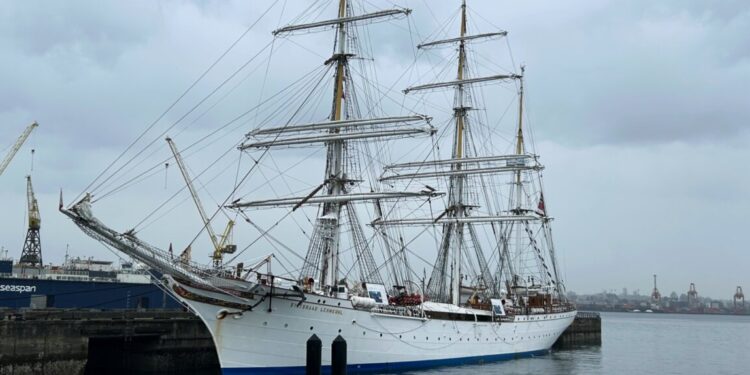The 111-year-old Norwegian tall ship Statsraad Lehmkuhl docked at Seattle’s Pier 66 on Wednesday as part of a worldwide expedition to promote ocean sustainability research.
The three-masted ship will be in Seattle from Wednesday to Monday as part of One Ocean Expedition, a multiyear voyage visiting 27 ports across three continents while circumnavigating the globe, according to the Port of Seattle. The visit coincides with One Ocean Week, hosted by Washington Maritime Blue.
The 322-foot-long ship is primarily a sail training vessel with 135 crew members. German merchant cadets trained on the Statsraad Lehmkuhl, built in 1914, before it became a Norwegian training ship in 1921.
“Celebrate the past and sail toward the future aboard a ship that has trained sailors for more than a century, survived two world wars, and now sails the globe powered in part by wind-charged batteries, blending maritime tradition with cutting-edge green technology and real-time ocean research,” the Port wrote in a blog post.
The ship, with a 157-foot-tall main mast, is “both fast and famous,” with a top speed of up to 19 knots (or 21 mph), according to the Port of Seattle. Its home port is Bergen, Norway, one of Seattle’s sister cities.
One Ocean Week, from October 20 to October 26, features summits, community events and a focus on “catalyzing the Blue Economy while leading on climate action, ecosystem health, and equity,” as stated on the website.
Maritime Blue is hosting several public access events for people to board and tour the boat.
The Statsraad Lehmkuhl’s 111-year history spanning German origins, Norwegian acquisition, and two world wars provides living maritime heritage rarely preserved in operational sailing vessels, with most tall ships from that era either scrapped or converted to museums rather than remaining seaworthy.
The 27-port itinerary across three continents demonstrates ambitious scope for ocean research collection, with the ship serving as a floating laboratory gathering data on ocean conditions, pollution levels, and marine ecosystems that scientists compare across global regions.
The wind-charged battery technology represents innovative hybrid propulsion combining traditional sail power with modern renewable energy storage, allowing the vessel to reduce diesel engine use while maintaining auxiliary power for instruments, lighting, and navigation systems.
Seattle’s sister city relationship with Bergen, Norway, dating to 1975, creates cultural connections that make the Statsraad Lehmkuhl’s visit particularly meaningful for Norwegian-American communities concentrated in the Pacific Northwest, especially in Ballard and other historically Scandinavian neighborhoods.
The 135 crew members aboard a 322-foot vessel indicates substantial manning levels compared to modern cargo ships of similar length that operate with crews of 20 or fewer, reflecting the labor-intensive nature of traditional sailing operations and the ship’s training mission.
The 19-knot top speed compares favorably to many modern sailboats despite the vessel’s century-old design, with the three-masted square-rigged configuration providing substantial sail area that captures wind efficiently for a hull optimized for speed during its original merchant service.
One Ocean Week’s timing coinciding with the ship’s Seattle visit creates synergy between the vessel’s research mission and Washington Maritime Blue’s initiatives promoting sustainable maritime industries, clean shipping technologies, and ocean ecosystem protection.
Pier 66’s location on Seattle’s central waterfront provides high visibility for the tall ship, with thousands of tourists and commuters passing daily who will see the distinctive three-masted silhouette contrasting with modern cruise ships and ferries typically docked there.
The public access tours hosted by Maritime Blue offer rare opportunities for Seattleites to board a historic sailing vessel and learn about traditional seamanship, with such experiences increasingly uncommon as tall ships decline in number and concentrate visits in major maritime heritage ports.
The Blue Economy focus of One Ocean Week encompasses commercial fishing, aquaculture, renewable ocean energy, maritime transportation, and coastal tourism, sectors where Washington state holds leadership positions that the conference aims to expand while improving environmental performance.







